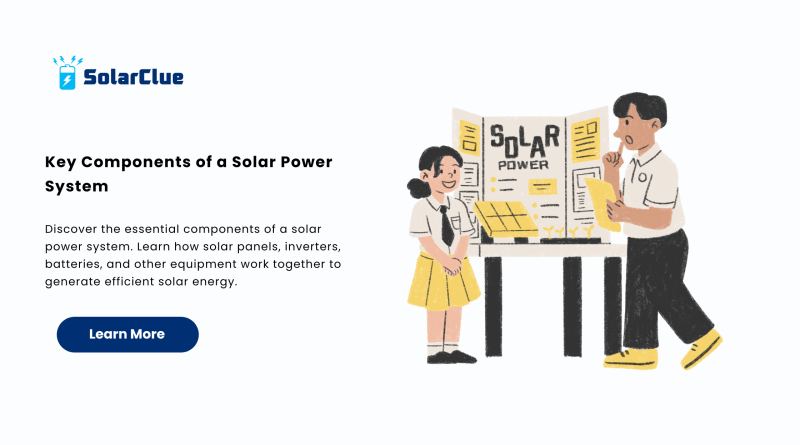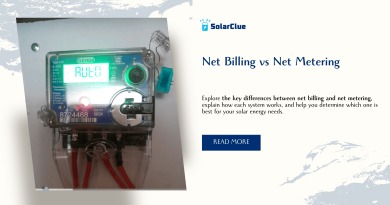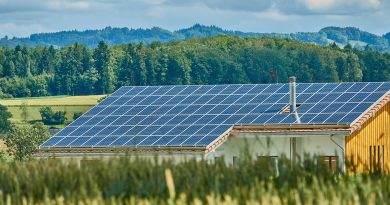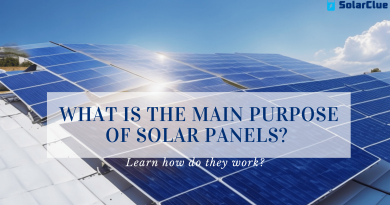Key Components of a Solar Power System
Harnessing the power of the sun has never been more efficient and accessible. A solar power system is more than just a panel on a roof; it’s a well-engineered setup of various technologies working in unison. In this blog, we’ll break down the key components of a solar power system, how they function together, and what you need to know before making the switch to solar energy.
Table of Contents
- 1 What is a Solar Power System?
- 2 1. Solar Panels – The Energy Generators
- 3 2. Inverters – Converting Energy for Use
- 4 3. Mounting Structures – Supporting the Panels
- 5 4. Solar Batteries – Storing the Power
- 6 5. Charge Controller – Managing the Flow
- 7 6. Electrical Wiring – Connecting All Parts
- 8 7. Monitoring Systems – Real-Time Performance Tracking
- 9 8. Net Meter – Calculating Surplus Energy
- 10 Benefits of a Solar Power System
- 11 Choosing the Right Solar System for Your Needs
- 12 Common Misconceptions About Solar Energy
- 13 Solar Energy and Environmental Impact
- 14 Cost and Return on Investment
- 15 Is Solar Power Right for You?
- 16 Maintenance and Longevity
- 17 Final Thoughts
- 18 FAQs
What is a Solar Power System?
A solar power system converts sunlight into electricity using a combination of high-performing components. It provides sustainable energy for residential, commercial, and industrial applications. With rising energy costs and growing environmental awareness, more homeowners and businesses are turning to solar to reduce their carbon footprint and electricity bills.
1. Solar Panels – The Energy Generators
Solar panels are arguably the most visible and recognized part of a solar power system. These panels consist of photovoltaic (PV) cells that capture sunlight and convert it into direct current (DC) electricity. There are several types of solar panels, including monocrystalline, polycrystalline, and thin-film panels.
Types of Solar Panels:
- Monocrystalline Panels: High efficiency and sleek appearance
- Polycrystalline Panels: Cost-effective but slightly less efficient
- Thin-Film Panels: Lightweight and flexible, ideal for non-traditional installations
2. Inverters – Converting Energy for Use
The DC electricity generated by solar panels must be converted into alternating current (AC) to power appliances. That’s where the inverter comes in. Inverters are critical components that ensure your solar energy is usable for everyday needs.
Types of Inverters:
- String Inverters: Centralized conversion for multiple panels
- Microinverters: Installed on each panel for optimized output
- Hybrid Inverters: Combine solar and battery inputs
3. Mounting Structures – Supporting the Panels

Mounting systems provide structural support to solar panels, ensuring they are properly angled and secure. These frames are essential for maximizing sunlight exposure and protecting the panels from environmental damage.
Common Mounting Types:
- Roof-mounted: Ideal for homes with adequate rooftop space
- Ground-mounted: Suitable for larger properties or solar farms
- Pole-mounted: Adjustable and often used in rural settings
4. Solar Batteries – Storing the Power
A solar power system with storage capability uses batteries to store excess electricity for later use. This is especially beneficial in off-grid systems or areas with frequent power outages.
Battery Options:
- Lead-acid batteries: Affordable but heavier
- Lithium-ion batteries: Long lifespan and efficient
- Flow batteries: Great for large-scale storage needs
5. Charge Controller – Managing the Flow
The charge controller regulates the flow of electricity between the solar panel, battery, and load. It prevents overcharging and deep discharging, thus extending battery life and enhancing system efficiency.
6. Electrical Wiring – Connecting All Parts
Cables and connectors are the veins of your solar power system. They transport electricity between components while minimizing losses. Proper wiring ensures safe and reliable energy transmission.
Wiring Essentials:
- DC and AC cables
- MC4 connectors
- Fuse boxes and junction boxes
7. Monitoring Systems – Real-Time Performance Tracking
Modern solar energy systems include monitoring devices that track real-time performance, energy production, and system health. Many offer mobile apps and online dashboards for convenience.
8. Net Meter – Calculating Surplus Energy
In grid-tied systems, a net meter measures the electricity fed back into the grid. This enables users to earn credits, lowering their utility bills through net metering policies.
Benefits of a Solar Power System
Switching to solar offers numerous advantages:
- Reduces electricity costs
- Provides energy independence
- Increases property value
- Minimizes environmental impact
Choosing the Right Solar System for Your Needs
Before investing, assess your energy needs, available space, and budget. Consult a certified solar installer for a customized solution. For expert advice and product selection, visit solarclue.com.
Common Misconceptions About Solar Energy
- “Solar doesn’t work in cloudy weather”: While efficiency decreases, solar panels still generate power.
- “Solar systems are too expensive”: Costs have significantly decreased, and subsidies are available.
- “Maintenance is difficult”: Modern systems require minimal upkeep.
Solar Energy and Environmental Impact
By using solar power, you’re reducing dependence on fossil fuels and cutting greenhouse gas emissions. A typical residential solar panel system can offset tons of CO2 annually.
Cost and Return on Investment
A well-designed solar power system pays for itself within 4–7 years through energy savings and incentives. Many regions offer tax credits, rebates, and net metering options to improve ROI.
Is Solar Power Right for You?
Evaluate your local climate, sunlight exposure, and energy consumption. Use tools on blog.solarclue.com to estimate your savings and learn more about installation options.
Maintenance and Longevity
Most solar panels last 25–30 years with minimal maintenance. Regular cleaning and occasional inspections are enough to keep your system in top shape.
Final Thoughts
A solar power system is a smart, sustainable investment with long-term benefits. Understanding each component helps you make informed decisions and get the most from your system.
To explore high-quality products and professional guidance, check out our curated solutions at solarclue.com — your journey to solar energy excellence starts here!
FAQs
Q1: How many solar panels do I need for my home?
A: It depends on your electricity usage and location. On average, a 3-5 kW system suffices for a typical household.
Q2: Can I go off-grid with a solar power system?
A: Yes, with adequate battery storage and sizing, off-grid systems are feasible and increasingly popular.
Q3: Are there government incentives for installing solar?
A: Many countries offer tax credits, rebates, and net metering policies to make solar more affordable.
Q4: What’s the lifespan of a solar battery?
A: Most lithium-ion solar batteries last between 10-15 years, depending on usage and maintenance.
Q5: Do solar panels increase property value?
A: Yes, homes with solar systems typically sell faster and at higher prices due to reduced operating costs.
Ready to power your future with clean energy? Take the first step by exploring solarclue.com — your trusted partner in solar transformation!




